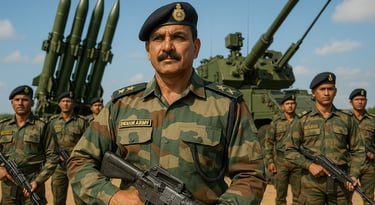India’s Offensive Defence Doctrine: What It Means
India seeks peace — but not at the cost of preparedness.
INDIAN DEFENCE
Gone are the days when India's military posture was purely reactive. The evolution of India’s defence strategy over the past two decades has led to the rise of a bold new approach: the Offensive Defence Doctrine. It reflects a mindset shift — from waiting to respond, to striking first, fast, and decisively when threatened. In a region marked by volatile borders and asymmetric warfare, India’s doctrine is not just about retaliation — it’s about strategic assertion.
What is Offensive Defence?
Offensive Defence doesn’t mean war-mongering — it means pre-emptive strength.
It’s the idea that if India faces a credible threat — especially from terrorism, hybrid warfare, or cross-border provocation — it will not hesitate to strike inside enemy territory. This doctrine enables India to:
Neutralize threats at their source
Deter future attacks with calibrated action
Maintain escalation dominance without being dragged into a full-scale war
It was this doctrine that justified India’s 2016 Surgical Strikes across the LoC and the 2019 Balakot Air Strikes in response to the Pulwama terror attack.
“India will not initiate war. But if war is thrust upon us, we will use all our strength to win it.” – A principle echoed since Field Marshal Sam Manekshaw.
How This Doctrine Changed the Game:
India's previous doctrine emphasized strategic restraint. While effective in maintaining peace, it was often seen as passive, even when provoked.
But the Offensive Defence Doctrine, under current leadership and military modernization, asserts:
Swift response using special forces, air power, and cyber ops
No tolerance for proxy war or state-sponsored terrorism
Flexible retaliation — below the threshold of full-scale war
India demonstrated this by:
Crossing the LoC to dismantle terror launch pads in 2016
Targeting Jaish-e-Mohammed training camps deep inside Pakistan in 2019
Upgrading border rules of engagement, especially post-Galwan standoff with China
This posture deters enemies by creating uncertainty and fear of consequences.
Modernization Enabling the Doctrine
Offensive defence isn’t just about intent — it needs tools. India is rapidly upgrading its capabilities:
Rafale & Tejas fighters, long-range strike missiles like BrahMos, and Pinaka rocket systems
Satellite intelligence, drones, and real-time battlefield surveillance
Integrated theatre commands for faster tri-service action
Stronger cyber, EW (electronic warfare), and space command integration
The doctrine blends kinetic power with digital precision, making India ready to hit harder and faster — even before an enemy completes its move.






⚖️ Balancing Power with Responsibility
Despite this aggressive edge, India’s doctrine remains measured and rules-based. It respects:
International law
Minimum civilian harm
Avoidance of escalation into total war
India uses offensive defence only when provoked — keeping the moral high ground while safeguarding national security.
It’s not about aggression — it’s about strategic preparedness with clear red lines.
Final Word: A Doctrine for a New India
The Offensive Defence Doctrine reflects a confident, assertive India — one that no longer waits to bleed before responding. It’s a message to every adversary: India may be peaceful, but it is never passive.
“Strike not out of anger, but out of strategy. That’s the essence of India’s new doctrine.”
In the age of hybrid threats and unpredictable warfare, Offensive Defence is not an option — it’s a necessity.


